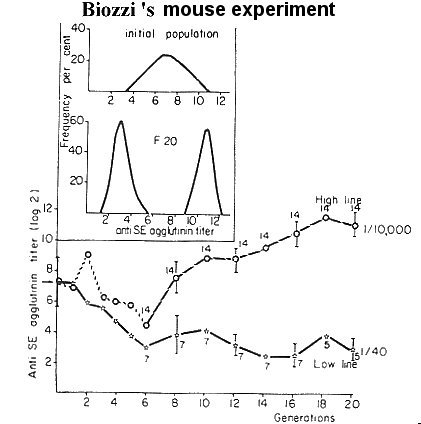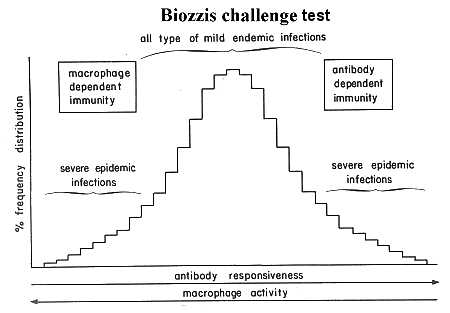Experimental selections of layers for resistance to neoplasma fatalities.

The literature displays many reports of selection against inherited diseases, but in most cases it concerns simple recessive traits, which, according to routine, are kept at an acceptable low level. Naturally, some problems arise in the cases where the selection is counteracted, which is the case when overdominance occurs. This is when the heterozygotes have a higher fitness than the homozygotes.
For diseases with polygenic disposition, only a few reports show successful
experimental selection of the
large domestic animals. The results, proving better resistance to diseases, have mainly been obtained
by crossbreeding. But not only in theory, but also in practice, it has been possible
to obtain significant results of selection against specific diseases.
In the breeding of egg layers, the results have been just as clear as it has for
experimental selections of laboratory animals.
Here is described an experiment carried out by Cole and Hutt (1973, Anim. Breed. Abstra. 41:103-118),
see Figure 12.3.
| Figure 12.3. Experimental selections of layers for resistance to neoplasma fatalities. |
 |
In 1935 two lines were established, C and K. The two lines respectively had 14.2 % and 11.3 % neoplasma fatalities due to leucosis including Marek's disease. In the period 1935-69, 34 generations were produced in each of the two lines.
The initial generation was not selected, but in the following generations the resistant breeding animals from the two lines were selected. In 1935 also a third line, S, was established, this one was based on individuals which were susceptible to leucosis (susceptible line). This line was maintained in the following generations by continued selection of the susceptible animals. The three lines were placed in the same production system. The environment was supposed to be infected by virus during the entire experimental period, except for the period 1958-61 (cf. the figure). The figure clearly shows that selection has been fairly effective concerning both points. At the end of the experiment (1967-69) the susceptible line had neoplasma fatalities of around 60%, while the two resistant lines, C and K, had neoplasma fatalities of respectively 3.7 % and 0.9 %. During the same period the total amounts of fatalities were reduced from respectively 51.5 % (C) and 44.4 % (K) to 12.7 % and 8.0 %. The fatalities in the period were counted in the period of 43 to 500 days after hatching. The mentioned results of the selection obtained even a fairly low estimated heritability, and were at the same time selected for several other traits. The good results could be explained by the fact that progeny test was used as a criterion of the selection. Furthermore Cole and Hutt argue that the same results could have been obtained in a significantly shorter time, if the strong progeny test had been used during the entire period.
As leukocytes are of great importance to the development of resistance, it is important to
find out whether or not it is possible to
select for a high or low content of leucocyte in the blood (WBC= white blood cell). Such an experiment has been carried
out on mice by Chai 1975, J.Heredity 66:301-309. In the initial population (generation 0) the leukocyte counts were
6-8 x 103 per mm3. After 22 generations of selection for HLC (high leucocyte count) and LLC (low leucocyte count)
lines the counts were respectively 36-38 x 103 and 4-5 x 103. The
examined control population had reached a level of around
103, which is close to the level in the initial population. The small difference is
supposed to be caused by 'random genetic drifting'.
In relation to this experimental selection it ought to be mentioned, that the
obtained response from the selection corresponds to h2 at
0.20 for lymphocyte counts, which also has been estimated in cattle. If it is
desirable, the lymphocyte count can easily be changed
by selection.
| Figure 12.4. Experimental selections for high or low anti sheep erythrocytes titter in mice. |
 |
Biozzi et al. (1972, J.Exp.Med. 135:1071-1094) made a selection experiment of mice for respectively high and low anti body response in relation to experimental immunization by means of sheep erythrocytes (SE), see figure 12.4. It appears from the figure, that the initial population had a titter with a mean value of around 1000 (ln 1000 = 6,9). After 20 generations of selection in each direction, the two populations had obtained titters of respectively 40 and 10.000. Furthermore, it was shown that the "high line" responded strongly to several other antigens, even though the selection was only done for responses to SE's. In the light of this it was easy to imagine that selection for general resistance to disease was possible, simply by selecting for high immunoglobulin concentrations in the serum. That this is in fact possible has been shown by Jensen & Christensen (1975, J.Anim.Sci. 40:392-396), who found that IgG 2 in dairy cattle had a heritability of 0.2.
To test the generalization of Biozzi et al. (1972, J.Exp.Med. 135:1071-1094), concerning the results of selection for high and low anti body response in mice in relation to experimental immunization, a long series of experimental infections on the two lines of mice have been carried out. It is worth realizing that the fact that the line with a high general anti body response also tended to have a lower cellular defence based on macrophagical activity. This means that individuals with a strong cellular defence remove the anti-genes by means of their macrophages. Therefore, the anti-genes are removed before anti bodies can be produced against them. Nature has apparently found a compromise between the cellular and the humoral immune defence, see Figure 12.5.
| Figure 12.5. Challenge experiments with different micro organisms on mice selected for high or low anti body titter against sheep erythrocytes.. |
 |
But back to Biozzi's challenge experiments (Biozzi et al. Proc. World Cong. on Genet. Appl. Livestock
Improvement, Madrid 4-8 oct 1982 Vol 5:150-163). They used challenge on more than 10
different pathogens
among these were Salmonella thypimurium and Rabies virus. Their main conclusion can be seen in Figure 12.5.
This figure shows that individuals, which have macrophage activity and immune response
around average, are only slightly affected
by most infections. Individuals with high immune response would be strongly affected by diseases, depending on
macrophage activity as their main defence. The reverse is true for diseases depending on a high humoral response.
Conclusion:
The conclusions drawn from the old experiments are: It is possible to select for special resistance, but
this type of selection will normally be overtaken by the possibilities of developing
a vaccine. Today it is possible to
vaccinate against leucosis among layers. Furthermore it must be concluded, that it is not possible to select for general
resistance by selecting for high or low immunity components, as they act reversely. The natural level,
with respect to infective agents, has to be
balanced in the population history. Which means that pure breeding cannot be
utilized to improve the general resistance. But what about crossbreeding?
By looking at Biozzi's graph from his challenge experiments it can be concluded, that the closer to the mean value an animal is the less severe disease it will have. The more extreme animals, on the other hand, would be exposed to the strongest attacks from disease. So a mean to obtain a low disease level in a population is to work with a uniform population of animals with an optimal mean immune response. Uniformity can be obtained in crossbred animals. Because of dominance conditions 2-ways, 3-ways and backcrosses are more uniform than pure bred animals. Therefore it should be possible to find combinations of crosses, which are optimal with respect to the exposure of a disease in a given production. F2 animals or 4-way crosses are more heterogene and therefore prone to acquire diseases. At present there are no practical experiments that can verify the presented postulates concerning different disease frequencies in different crossbred types. Therefore, experiments to elucidate these conditions are strongly recommended.